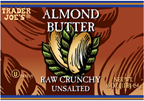At the 2007 IAFP annual meeting in Florida, CDC foodborne illness outbreak guru Robert Tauxe told symposium audience that the next big thing for food safety was low-moisture ingredients. Salmonella is hardy, especially when stressed through drying, so it sticks around for a while. It might not grow much without available water, many low-moisture foods are also high-fat which protects the pathogen in the gut and leads to a lower mean infectious dose. Tauxe’s comments were post- Salmonella Tennessee in Peter Pan peanut butter and pre- Salmonella Wandsworth in Veggie Booty (and other outbreaks) and he talked about dried spices and flavorings and peanut butter-type products like hummus and tahini. And almond butter.
According to a message on the Trader Joe’s website, the retailer is recalling specific lots of two types of of almond butter.
We have been alerted by our supplier of Trader Joe’s Raw Almond Butters that there is a possibility that product with the specified date codes may be contaminated with Salmonella:
Raw Crunchy Unsalted Almond Butter
SKU 91989
USE BY 28DEC14 thru 18JUN15
Raw Creamy Unsalted Almond Butter
SKU 56995
USE BY 27DEC14 thru 18JUL15
In accordance with our stringent health and safety standards, and as an extreme precaution, all of the potentially affected product has been removed from sale and destroyed.
Customers who have purchased any of these items with the specified code dates are urged to not eat them and to dispose of them or return them to any Trader Joe’s for a full refund.
No other Trader Joe’s products are included in this recall.
